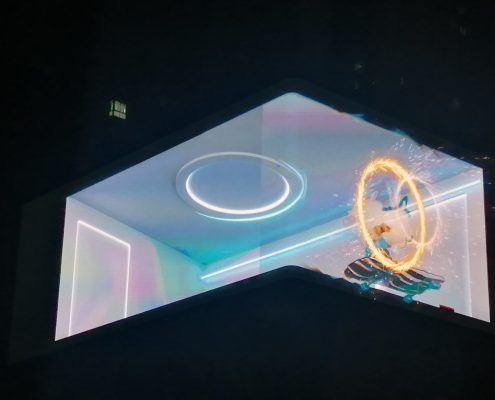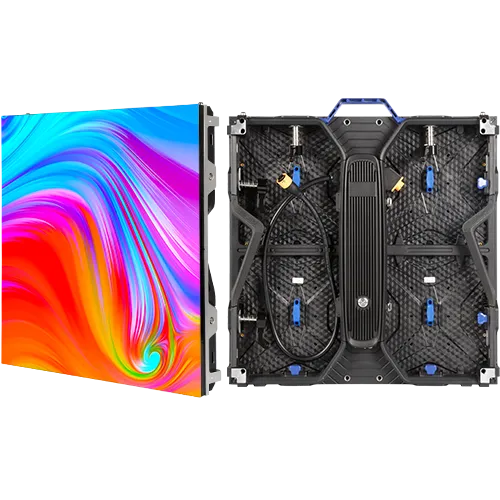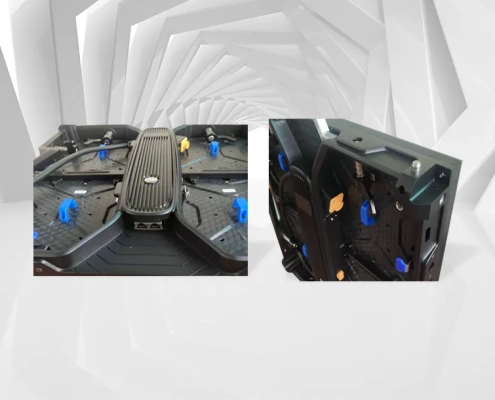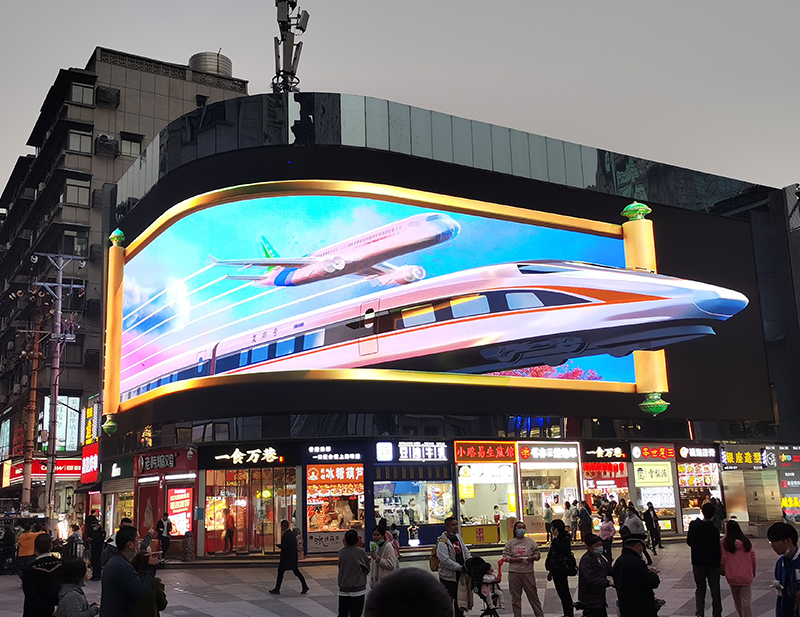Online Consultation or Need a Quote?
3D LED displays are a quantum leap from their 2D predecessors, offering an unparalleled depth of field and a realistic viewing experience that seems to extend beyond the physical boundaries of the screen. Unlike traditional 3D technology, which often requires special glasses, many 3D LED displays utilize glasses-free technology, making the 3D experience more accessible and enjoyable.
The core of a 3D LED display is its ability to project images in three-dimensional space, creating the illusion of depth and solidity. This is achieved through various techniques, including stereoscopy, volumetric, and holographic displays. Each method offers a unique way of perceiving depth and dimension, making the 3D LED screen display not just a tool for entertainment but a revolutionary medium for communication and information presentation.
The Evolutionary Path to 3D LED Displays
The journey of display technology has been nothing short of revolutionary, evolving rapidly from the early days of cathode-ray tubes to the sleek and efficient liquid crystal displays (LCDs) and light-emitting diodes (LEDs) we see today. This progression has been marked by significant milestones, each pushing the boundaries of what’s possible in visual representation. As we ventured into the 21st century, one of the most groundbreaking advancements has been the development of 3D LED display technology.
Initially, displays were limited to two-dimensional images, offering a flat and static viewing experience. However, as technology advanced, so did the desire for more immersive and lifelike visuals. The introduction of 3D technology in cinemas and televisions was the first step towards this new dimension of viewing, but it was the advent of 3D LED displays that truly transformed the landscape.
Delving Deeper into the World of 3D LED Displays
What is a 3D LED Display?
At the heart of the latest visual technology revolution is the “3D LED Display,” a term that signifies a leap from traditional flat imagery to a new realm where images seem to leap out of the screen. But what exactly is a 3D LED display? In essence, it’s a sophisticated device that employs light-emitting diodes (LEDs) to create a stunning illusion of depth, making the on-screen content appear as if it’s existing in a three-dimensional space. This isn’t just an incremental improvement over previous technologies; it’s a complete overhaul of the viewer’s visual experience.
The magic of a 3D LED display lies in its ability to trick the human eye into perceiving depth where there is none. This is achieved through various techniques, such as stereoscopy, where two slightly different images are presented to each eye, or autostereoscopy, which allows for the perception of 3D images without the need for special glasses. These naked-eye 3D displays are not just a marvel of visual experience but also come with energy-saving attributes. By using LEDs, which are known for their low power consumption and long lifespan, 3D LED displays are not only more immersive but also more environmentally friendly and cost-effective over time.
2D vs. 3D LED Displays
| Aspect | 2D LED Displays | 3D LED Displays |
| Dimensionality | Offer two dimensions: width and height. | Add a third dimension: depth, providing a more realistic view. |
| Perception | Limit viewers to a flat, static perception of images. | Offer a sense of depth, making content more realistic and engaging. |
| Visual Impact | Images are static and flat, confined to the surface of the screen. | Images extend outwards, creating a dynamic and immersive experience. |
| Engagement | Standard level of engagement with content being somewhat distant and less interactive. | Enhanced engagement as viewers feel drawn into the scene, making it more interactive and lifelike. |
| Applications | Used widely but with limited immersive experience, suitable for general viewing and traditional display needs. | Expanding applications in entertainment, education, design, and advertising due to its immersive and realistic representation. |
| Effectiveness | Effective for standard display purposes but lacks depth and immersion. | More effective in delivering an immersive experience, enhancing understanding and engagement in various fields. |
The Mechanics of 3D LED Displays
How 3D LED Displays Work?
Understanding the inner workings of a 3D LED Display is crucial to appreciating the technological marvel it represents. At its core, a 3D LED screen display is a sophisticated combination of hardware and software working in tandem to produce images with the illusion of depth. The hardware component is primarily the LED panel itself, composed of numerous tiny LEDs that act as individual pixels. These panels are not much different from those used in standard 2D displays, but the magic lies in how they are controlled and manipulated.
Each LED in a 3D display is capable of varying levels of brightness and color, allowing for detailed and nuanced images. The software controlling these LEDs is where the transition from 2D to 3D takes place. Advanced algorithms calculate and adjust the images from different angles, creating the illusion of depth. This is where parallax comes into play, a phenomenon where the position or direction of an object appears to differ when viewed from different angles, providing the viewer’s brain with the cues it needs to perceive depth.
Additionally, the manufacturing of these panels has evolved to include features like faster refresh rates and higher resolutions, which are crucial for maintaining the illusion of depth without causing discomfort or disorientation to the viewer.
Creating the 3D Effect
Creating the 3D effect on a 3D LED screen display involves manipulating light and perception to trick the human brain into seeing depth where there is none. Two primary techniques are used in this process: the manipulation of grayscales and the use of parallax.
- Grayscale Manipulation: Every LED in a display can produce a range of brightness levels, known as grayscales. By carefully controlling the brightness of each LED, the software can create shadows and highlights that mimic the way light falls on objects in the real world. This shading effect adds to the illusion of depth, making flat images appear three-dimensional.
- Parallax: Parallax plays a crucial role in 3D visualization. By displaying different images to each eye or changing the image based on the viewer’s position, the brain is tricked into perceiving depth. This can be achieved in several ways, including lenticular lenses, which direct light to the viewer’s eyes from different angles, or head-tracking technology, which adjusts the image based on the viewer’s position.
Together, these techniques create a convincing illusion of depth on a flat screen. The 3D effect is not just a simple trick but a complex illusion crafted through the precise control of light and perception. As technology advances, the mechanisms behind 3D LED displays continue to evolve, offering ever more realistic and immersive visual experiences.
Advantages of 3D LED Displays
Enhanced Visual Experience
One of the most compelling advantages of a 3D LED Display is the significantly enhanced visual experience it offers. This isn’t just about adding depth to images; it’s about creating a more immersive, engaging, and lifelike experience for the viewer. Several key factors contribute to this enhanced experience:
Ultra-High Definition: 3D LED displays often come with ultra-high definition (UHD) capabilities. This high resolution means that images are incredibly sharp and clear, with a level of detail that adds to the realism of the 3D effect. Each pixel on a 3D LED screen display contributes to a more defined and immersive image, making the 3D experience more convincing and enjoyable.
Superior Pixel Pitch: Pixel pitch refers to the distance between the centers of two adjacent pixels. In 3D LED displays, the pixel pitch is typically lower, meaning the pixels are closer together. This results in a smoother, more coherent image and reduces the risk of the ‘screen door effect,’ where visible gaps between pixels can disrupt the illusion of depth.
High Contrast Ratio: The contrast ratio is another critical factor in creating vivid and lifelike images. 3D LED displays generally have a high contrast ratio, which means they can produce deeper blacks and brighter whites. This range is crucial in creating the illusion of depth, as it allows for more subtle and effective shading, which is essential for rendering three-dimensional images convincingly.
Case studies from various sectors, including entertainment, advertising, and education, have showcased the stunning picture quality and realistic effects of 3D LED displays. In cinemas and home theaters, for instance, viewers report a more immersive and engaging experience, feeling as if they’re part of the scene. In advertising, 3D LED screens capture attention with their lifelike images, leading to higher engagement rates. In educational settings, complex concepts become easier to understand when presented in three dimensions, leading to better learning outcomes.
Energy Efficiency and Durability
Beyond the impressive visual capabilities, 3D LED displays also offer practical advantages in terms of energy efficiency and durability:
Energy Efficiency: LEDs are well-known for their energy efficiency, and this extends to 3D LED displays. They consume significantly less power compared to other lighting technologies, which not only reduces operational costs but also contributes to a lower environmental impact. The energy-saving aspect is particularly beneficial for large-scale or continuous use scenarios, such as in advertising billboards or public information displays.
Durability and Silent Operation: 3D LED displays are robust and built to last. They are less prone to damage and degradation over time compared to other types of displays. This durability makes them suitable for various environments, including outdoor settings where they may be exposed to harsh weather conditions. Additionally, LEDs operate silently, which is a significant advantage in environments where noise could be a distraction, such as in museums, galleries, or quiet public spaces.
Choosing the Right 3D LED Display
Selecting the appropriate 3D LED Display for your needs involves understanding various technical and environmental factors. Whether you’re setting up an immersive outdoor advertisement, enhancing a retail space, or creating a dynamic public installation, the right 3D LED screen display can make a significant difference in the impact and quality of your project.
When choosing a 3D LED display, several key factors will guide your decision to ensure you get a screen that meets your specific needs:
Pixel Pitch: The pixel pitch of a 3D LED display refers to the distance between the centers of two adjacent pixels. A smaller pixel pitch means a higher resolution, providing a clearer and more detailed image. Consider the viewing distance of your audience; closer viewing distances require a smaller pixel pitch for a clear image.
Brightness: The brightness of a 3D LED screen is crucial, especially for outdoor or brightly lit environments. A display with higher brightness ensures that the images remain clear and visible even in direct sunlight. However, for indoor environments, extremely high brightness might not be necessary and can even be uncomfortable for viewers.
Viewing Angles: Good viewing angles are essential for 3D LED displays to ensure that the 3D effect is visible from different positions. Wider viewing angles allow more people to experience the 3D effect without having to be directly in front of the screen.
Environmental Factors: Consider the environment where the 3D LED display will be installed. Outdoor screens need to be durable and resistant to weather conditions like rain, wind, and extreme temperatures. Indoor screens might have different requirements, such as lower brightness levels and more precise resolution.
Content Requirements: Think about the type of content you’ll be displaying. High-action videos, detailed graphics, or interactive content might have different requirements in terms of refresh rate, color accuracy, and resolution.
Applications of 3D LED Displays
The advent of 3D LED Display technology has opened up a new world of possibilities across various sectors. These displays are not just tools for viewing content; they are gateways to immersive experiences, offering depth and realism that traditional 2D screens cannot match. Here’s a closer look at five diverse applications where the 3D LED screen display is making a significant impact.
Revolutionizing Retail Spaces
In the competitive retail market, grabbing customer attention is paramount. 3D LED displays transform ordinary store windows and interiors into dynamic, engaging spaces. High-end brands use 3D visuals to showcase their products in lifelike scenarios, allowing customers to visualize the products in use. For instance, a 3D display might show a watch ticking on a wrist or a dress flowing as if in the wind, providing a much more engaging experience than traditional static images.
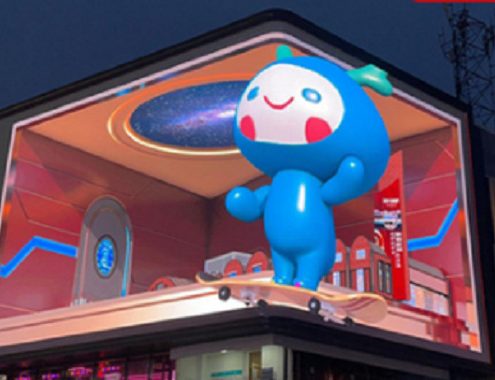
Enhancing Entertainment Venues
Cinemas, theaters, and concert venues are leveraging 3D LED displays to enhance the viewer’s experience. In cinemas, these displays provide a deeply immersive viewing experience, making the audience feel as if they’re part of the movie. Concerts and live performances use 3D LED screens to create dynamic backdrops that react and change with the music, adding a new layer of spectacle to the performance.
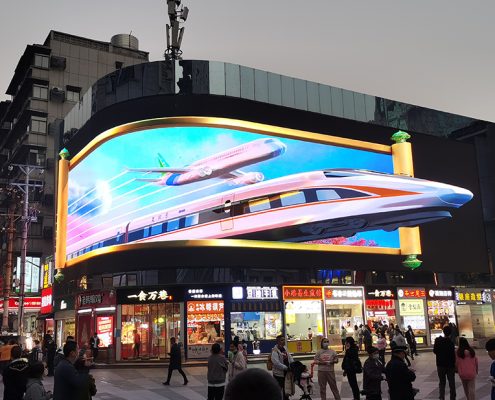
Transforming Public Spaces and Art Installations
Public spaces like parks, squares, and museums are adopting 3D LED displays to create interactive art installations and informational displays. These screens can show changing art pieces, provide interactive educational experiences, or display important public information in a way that’s engaging and accessible. The ability to create the illusion of depth adds a new dimension to public art, making it more engaging and noticeable.
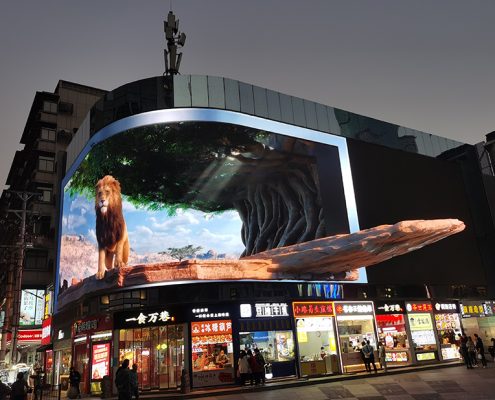
Innovating in Education and Training
Educational institutions and training programs are using 3D LED displays to bring complex concepts to life. In classrooms and lecture halls, these displays can show 3D models of anatomical parts, historical artifacts, or scientific phenomena, providing students with a clearer understanding of the subject matter. For specialized training, such as in medicine or aviation, 3D simulations on LED screens offer a realistic and immersive learning environment.
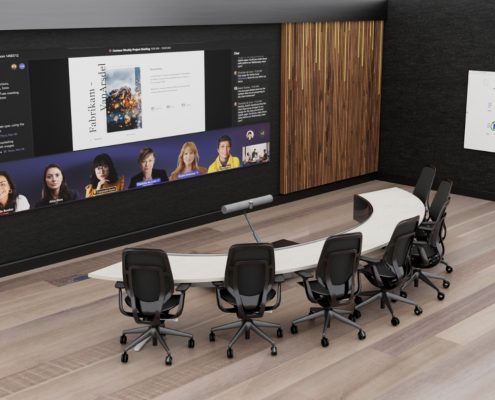
Elevating Corporate and Real Estate Presentations
Corporate boardrooms and real estate showrooms are utilizing 3D LED displays to make presentations more impactful. Businesses can present data, graphs, and models in three dimensions, making them easier to understand and more engaging. Real estate agents can offer virtual tours of properties using 3D models, allowing clients to explore spaces in a more intuitive and realistic way.
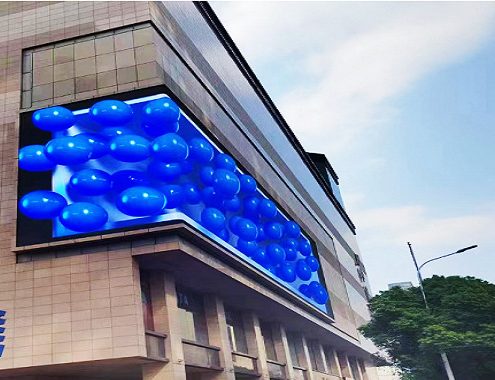
The Future of 3D LED Displays
The realm of 3D LED Display technology is one of rapid evolution and innovation. As we look to the future, it’s clear that this technology is not just about to change; it’s about to leap into new frontiers of realism, interactivity, and accessibility.
Innovations on the Horizon
The horizon is bright with potential innovations that will further enhance the capabilities and applications of 3D LED displays.
Smaller Pixel Pitches: As technology advances, we can expect to see even smaller pixel pitches, leading to higher resolution screens with even more detailed and lifelike images. This will be particularly impactful in environments where viewers are close to the screen, such as in retail or indoor advertising.
Integration with IoT: The integration of 3D LED displays with the Internet of Things (IoT) opens up a world of possibilities for interactivity and data display. Imagine screens that not only show content but also react to environmental conditions or viewer interactions. This could lead to displays that change content based on the time of day, weather, or even the number of people in front of the screen.
Advanced 3D Content Creation Tools: As the demand for 3D content grows, so too will the tools for creating it. We can expect more user-friendly, cost-effective solutions for creating stunning 3D visuals, making it easier for content creators to produce high-quality 3D content.
Augmented Reality (AR) Integration: Future 3D LED displays might seamlessly integrate with AR technology, creating a hybrid of real-world and digital content. This could be particularly impactful in fields like education, where such displays could provide immersive learning experiences that combine real-world objects with digital information.
Overcoming Limitations
While 3D LED displays offer incredible potential, there are still limitations that need to be addressed as the technology progresses.
Content Production Costs: Currently, producing high-quality 3D content can be expensive and time-consuming. However, as the technology becomes more widespread, we can expect the development of more efficient and cost-effective content creation tools and services.
Visual Fatigue: Prolonged viewing of 3D content can lead to visual fatigue or discomfort for some viewers. Research and development are ongoing to understand and mitigate these effects, potentially through more naturalistic 3D rendering techniques or displays that can adapt to the viewer’s perception.
Accessibility and Compatibility: Ensuring that 3D LED displays are accessible and compatible with a wide range of content sources and formats is crucial. Future developments will likely focus on standardizing 3D content and display protocols to ensure a seamless and user-friendly experience.
CONTACT US
Consult with Our Free Advisor for Your Next Project!

